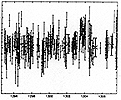For Educators

Graphing With RXTE
Overview:
This lesson uses real time data from the Rossi X-ray Timing Explorer (RXTE) satellite. The students will plot data by hand or by calculator. The highlight of this lesson will be using real-world data culminating in a performance task. The students will communicate their experience in the assessment question.
Links to Standards:
- Mathematics as Problem Solving
Students will:
- apply the process of mathematical modeling to real-world problem situations.
- acquire his/her methodology and reflect what they have experienced.
- Mathematics as Communication
Students will:
- communicate mathematical ideas comparing linear graphing to global graphing.
- express his/her methodology and reflect what they have experienced.
- Mathematics as Reasoning
Students will:
- reinforce logical reasoning skills by comparing and contrasting different methods for
graphing.
- evaluate the most appropriate method for graphing data.
- Mathematical Connections
Students will:
- investigate the connections between graphing by hand and graphing on calculators.
- be introduced to real time data sets.
- Algebra
Students will:
- represent situations with graphs and explore the interrelationships of these representations.
- analyze tables and graphs to identify relationships.
- Statistics
Students will:
systematically organize and describe data.
- construct, read and interpret tables and graphs that summarize data from a real-time
situation.
- make inferences and convincing arguments that are based on data analysis.
- analyze the effects of data transformations.
- Discrete Mathematics
Students will:
- represent real time data using a graph as an discrete structure.
- Mathematical Structure
Students will:
- compare and contrast the Cartesian graphing system and the Aitoff graphing system
with regards to their structural.
- appreciate that seemingly different mathematical systems may be essentially the same.
- apply the process of mathematical modeling to real-world problem situations.
Grade/Level:
Grade 9-12, Algebra 1 and 2, can be used as a review for upper level topics.
Prerequisite Knowledge:
Students should have the following skills:
- know what an ordered pair is
- know how to write an ordered pair
- know the four quadrants of a Cartesian graph
- know how to label a Cartesian graph
- know how to use the list function on the calculator*
- know how to plot points on the calculator*
- know how to use the global function of the calculator**
* for students/classes using the graphing calculator
** for students/classes using the TI-92 calculator
Objective:
The students will be able to:
- read a table
- identify the independent and dependent table values
- plot data coordinates
- discuss their method of graphing
- list coordinates as an ordered pair
- plot ordered pairs
- make a graph
Materials/Resources/Printed materials:
- Activity sheet for students
- Real time data - or static data.
- Answer key/Teacher lesson notes
- Graphing calculator
- Overhead projector unit for graphing calculator
- Blank copies of the
Aitoff projection map without numbered axes,
with numbered axes, and
Cartesian map without numbered axes - Rubric for assessment question
Development/Procedure
During this lesson, students will be working cooperatively. Ideally 3 students to a group. Assign a role to each student in the group. The roles are: MATERIAL MANAGER (the student who is in charge of getting the activity sheet, graph paper for the group), the TIME KEEPER ( the student who makes sure that everyone stays on task according to the allotted activity time) and the GROUP ORGANIZER (the student who makes sure that everyone has an assignment and participates in the group, s/he can also divide the assignment between the group members). The lesson should only take one 50 minute class period. The assessment question should be assigned for homework and each student should complete it and return it the next day. It is assumed that the teacher who allows students to use the calculator is knowledgeable of the calculator's usage for graphing and plotting points. There are no calculator instructions in the teacher notes. However, included in the notes are suggestions for calculator extension activities.
The teacher has the option of using the data on the student activity or researching real time data. The most useful handling of the data would be to access the real time data and choose one source type and follow that source down the list for galactic coordinates. For example, in the student activity I chose pulsars and followed the list of sources for the galactic coordinates for every pulsar. This will allow your lesson to be unique every time you use it and allow you to discuss a different source each time. This can be a good connection between science and math. In addition, note that the real time data is updated every three hours.
Performance Assessment:
The performance assessment is the last question in the activity sheet.
This lesson plan was created by:
Rachelle Andrews
Parkdale High School
Prince George's County Public School
Gervette@aol.com
 Welcome |
 Getting Started |
 Lesson Plans |
 Take Me To Your Data |


